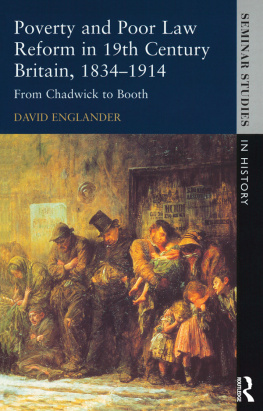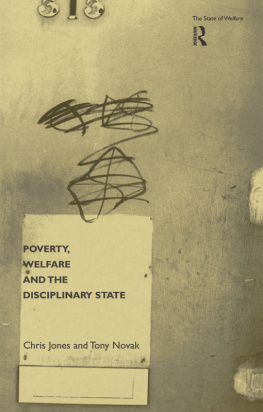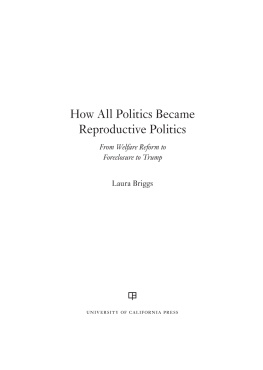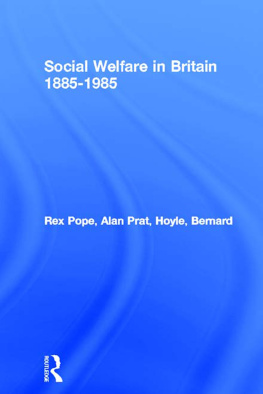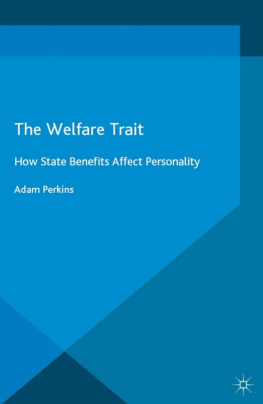
PEOPLE, MARKETS, GOODS:
ECONOMIES AND SOCIETIES IN HISTORY
Volume 5
Population, Welfare and
Economic Change in Britain
12901834
Population, Welfare and Economic Change presents the latest research on the causes and consequences of British population change from the medieval period to the eve of the Industrial Revolution, in both town and countryside. Its overarching concern is with the economic and demographic decision-making of individuals and groups and the extent to which these were constrained by institutions and resources. Within this, the volumes particular focus is on population growth: its causes and the welfare challenges it posed. Several chapters investigate the success with which the English Old Poor Law provided care for the poor and elderly, and new work on alternative welfare institutions, such as almshouses, is also presented.
A further distinctive feature of this book is its comparative perspective. By making systematic comparisons between economic and demographic developments in pre-industrial Britain and those taking place in various regions of contemporary Continental Europe and Russia, several chapters uncover how far Britain in this period was different. Stimulating to experts and students alike, Population, Welfare and Economic Change offers overviews and summaries of the latest scholarship by leading economic historians and historical demographers, alongside detailed case studies which showcase the original research of younger scholars.
PEOPLE, MARKETS, GOODS:
ECONOMIES AND SOCIETIES IN HISTORY
ISSN: 20517467
Series editors
Barry Doyle University of Huddersfield
Nigel Goose University of Hertfordshire
Steve Hindle The Huntington Library
Jane Humphries University of Oxford
Kevin ORourke University of Oxford
The interactions of economy and society, people and goods, transactions and actions are at the root of most human behaviours. Economic and social historians are participants in the same conversation about how markets have developed historically and how they have been constituted by economic actors and agencies in various social, institutional and geographical contexts. New debates now underpin much research in economic and social, cultural, demographic, urban and political history. Their themes have enduring resonance financial stability and instability, the costs of health and welfare, the implications of poverty and riches, flows of trade and the centrality of communications. This new paperback series aims to attract historians interested in economics and economists with an interest in history by publishing high quality, cutting edge academic research in the broad field of economic and social history from the late medieval/early modern period to the present day. It encourages the interaction of qualitative and quantitative methods through both excellent monographs and collections offering path-breaking overviews of key research concerns. Taking as its benchmark international relevance and excellence it is open to scholars and subjects of any geographical areas from the case study to the multi-nation comparison.
PREVIOUSLY PUBLISHED TITLES IN THE SERIES ARE LISTED AT THE END OF THE VOLUME

Contents
Chris Briggs, P. M. Kitson and S. J. Thompson
E. A. Wrigley
Bruce M. S. Campbell and Lorraine Barry
Rebecca Oakes
Julie Marfany
Samantha Williams
Jeremy Boulton
S. J. Thompson
Nigel Goose and Margaret Yates
Tracy K. Dennison
Sheilagh Ogilvie
R. W. Hoyle
Acknowledgements
The chapters in this book developed out of papers presented at Fitzwilliam College, Cambridge in September 2011 as part of a conference on Population, economy and welfare, c.12002000, organized by the editors. This meeting was held to celebrate the scholarly achievements of Richard Smith, following his retirement as Professor of Historical Geography and Demography in the Department of Geography, University of Cambridge, at the end of 2010. We would particularly like to thank Richard, who was also Director of the Cambridge Group for the History of Population and Social Structure from 1994 to 2012, for his intellectual generosity, encouragement and support. The editors are also grateful to everyone who took part in the 2011 meeting, especially those whose conference papers we were unable to include in this book. We also thank the following for providing financial support: the Managers of the George Macaulay Trevelyan and Ellen McArthur Funds, Faculty of History, University of Cambridge; the Centre for History and Economics, Cambridge and Harvard; and the Economic History Society.
The Editors
1 April 2014
Abbreviations
| ADB | Arxiu Dioces de Barcelona |
| AHG | Arxiu Histric de Girona |
| BLARS | Bedfordshire and Luton Archives and Records Service |
| BRO | Berkshire Record Office |
| CAMPOP | Cambridge Group for the History of Population and Social Structure |
| CJ | Commons Journal |
| COWAC | City of Westminster Archives Centre |
| GDP | Gross Domestic Product |
| NCA | Oxford, New College Archives |
| ODNB | Oxford Dictionary of National Biography |
| OED | Oxford English Dictionary |
| PP | Parliamentary Papers |
| RGADA | Rossisskii Gosudarstvennyi Arkhiv Drevnikh Aktov (Russian State Archive of Old Documents) |
| RGIA | Rossisskii Gosudarstvennyi Istoricheskii Arkhiv (Russian State Historical Archive) |
| TNA | London, The National Archives |
| VCH | Victoria County History |
| WCA | Winchester College Archive |
Introduction
CHRIS BRIGGS, P. M. KITSON AND S. J. THOMPSON
This is a book about the character, causes and consequences of population change between the late thirteenth century and the early nineteenth century. Its focus is England, but this case is set in context through chapters which compare English material with evidence from Scotland, Wales, various parts of southern and northern Continental Europe, and Russia.
Overall, these five centuries were a period of demographic growth in England and Great Britain. Bruce Campbells estimates presented below suggest that the population of Great Britain almost doubled between 1290 and 1801, rising from approximately 5.8 million to around 10.8 million, while that of England rose from 4.75 million to 8.6 million ( The second phase is an eighteenth- and early-nineteenth-century era of much more rapid population growth. Commenting on this phase of growth in his chapter below, Tony Wrigley notes that between 1731 and 1821 the population increased from 5.41 million to 11.46 million, or by a striking 112 per cent.
These different phases of Englands demographic history form the essential background to the studies that follow. Yet the primary concern of this volume is not the charting of aggregate population trends, or even the detailed statistical investigation of the demographic processes underlying those trends, a style of analysis that at times causes historical demography to appear to be, as Campbell notes, a technical and highly specialised subject. Instead, the principal objective of the book is to present new research and arguments which shed light on the historical contexts of demographic decisions broadly defined: decisions about marriage, migration, household formation, retirement, child-bearing, work and saving. In this Introduction, we provide an overview of the chapters which follow, and also tease out a fundamental conceptual question that is present throughout the book as a whole. Drawing on the title of Sheilagh Ogilvies chapter, one might say that our theme is the oscillation between choices and constraints in shaping demographic and economic behaviour in the past. In other words, to what extent did demographic decisions and outcomes reflect the free choice of individual agents in response to changing economic opportunities and imperatives, as opposed to the constraints that humanly devised social, legal and political structures impose in any given society, and that themselves are also subject to alteration over time? Of these structures, or institutions, those which provided for the welfare of the poor are among the most important in the present context. It is therefore natural and appropriate that welfare should form the third component of this books title, along with population and economic change.





